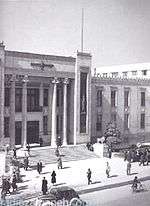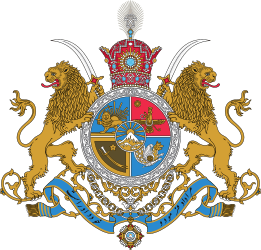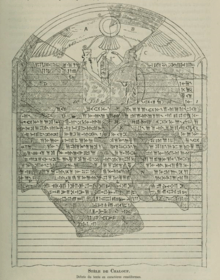Faravahar
Faravahar (Persian: فَرَوَهَر), also known as Forouhar (Persian: فُروهَر) , or Farr-e Kiyâni (فَرِّ کیانی), is one of the most well-known symbols of Iran (Persia), and Zoroastrianism, the primary religion of Iran before the Muslim conquest of Iran, and of Iranian nationalism.[1][2] There are various interpretations of what the faravahar symbolizes, and there is no universal consensus except to note that it does not represent the fravashi.[3][4]

| Part of a series on |
| Zoroastrianism |
|---|
Atar (fire), a primary symbol of Zoroastrianism |
|
Primary topics |
|
Divine entities
|
|
Scripture and worship |
|
Accounts and legends |
|
Related topics |
|
|
The Faravahar is one of the best known symbols of Iran and is often worn as pendant among Iranians, including Zoroastrians and Kurds and has become a secular national and cultural symbol.[5][6][7]
Etymology
The New Persian word فروهر is read as forouhar or faravahar (pronounced as furōhar in Old Persian). The Middle Persian forms were frawahr (Book Pahlavi: plwʾhl, Manichaean: prwhr), frōhar (recorded in Pazend as 𐬟𐬭𐬋𐬵𐬀𐬭; it is a later form of the previous form), and fraward (Book Pahlavi: plwlt', Manichaean: frwrd), which was directly from Old Persian *fravarti-.[3][8] The Avestan language form was fravaṣ̌i (𐬟𐬭𐬀𐬎𐬎𐬀𐬴𐬌).
In Iranian and Zoroastrian culture
_I.jpg)
The faravahar was depicted on the tombs of Achaemenid kings, such as Darius the Great (r. 522–486 BC) and Artaxerxes III (r. 358–338 BC).[9] The symbol was also used on some of the coin mints of the frataraka of Persis in the late 3rd and early 2nd BC centuries.[10] Even after the Arab conquest of Iran, Zoroastrianism continued to be part of Iranian culture. Throughout the year, festivities are celebrated such as Nowruz, Mehregan, and Chaharshanbe Suri which relate to Zoroastrian festivals and calendar. These are remnants of Zoroastrian traditions. From the start of the 20th century, the faravahar icon found itself in public places and became a known icon among Iranians. The Shahnameh by Ferdowsi is Iran's national epic and contains stories (partly historical and partly mythical) from pre-Islamic Zoroastrian times. The tomb of Ferdowsi (built early 1930), which is visited by numerous Iranians every year, contains the faravahar icon as well.[11]
Whilst being used by both modern day Zoroastrians and Persians, it is important to note the symbol is neither Zoroastrian nor Persian in its origin. It originates as an Mesopotamian Assyrian depiction of the wing deity Ashur. After the Achaemenian dynasty, the image of the farohar was no longer present in Persian art or architecture. The Parthians, Sassanians and Islamic kings that followed did not use the image. It was not until the 20th century, over 2000 years later, that the symbol re-emerged thanks to the work of Parsi scholar, Jamshedji Maneckji Unvala who published two articles in 1925 and 1930.[12][13]
Unvala's work was discredited by Irach Jehangir Sorabji Taraporewala, who refuted the idea that the winged figure represented Ahura Mazda. Taraporewala suggested that the figures used in Persian reliefs were meant to depict khvarenah or royal glory to reflect the perceived divine empowerment of kings, and, therefore, has no true spiritual meaning. This view was later supported by Alireza Shapour Shahbazi and Mary Boyce.[14][15][16]
The Sun Throne, the imperial seat of Iran, has visual implications of the Farahavar. The sovereign would be seated in the middle of the throne, which is shaped like a platform or bed that is raised from the ground. This religious-cultural symbol was adapted by the Pahlavi dynasty to represent the Iranian nation.[17] In modern Zoroastrianism, one of the interpretations of the faravahar is that it is a representation of the human soul and its development along with a visual guide of good conduct.[1] Another popular interpretation is that it is a visual representation of a Fravashi, though Fravashis are described in Zoroastrian literature as being feminine.[3] One of the most prevalent views in academia as to the meaning of the faravahar is that it represents Khvarenah, the divine power and royal glory.[3] Although there are a number of interpretations of the individual elements of the symbol, most are recent interpretations and there is still debate as to its meaning.
After the Islamic Revolution of 1979, the Lion and Sun, which was part of Iran's original national flag, was banned by the government from public places in order to prevent people from being reminded of life prior to the revolution. Nevertheless, faravahar icons were not removed and as a result, the faravahar icon became a national symbol for Iranians, and it became tolerated by the government as opposed to the Lion and Sun.[18] The winged discs has a long history in the art, religion, and culture of the ancient Near and Middle East, being about 4000 years old in usage and noted as also symbolizing Ashur, Shamash, and other deities.[1]
Gallery
- Persepolis, Iran.
 The Faravahar portrayed in the Behistun Inscription
The Faravahar portrayed in the Behistun Inscription Museum of Zoroastrians, Kermǎn
Museum of Zoroastrians, Kermǎn National bank of Iran (1946) containing the Farvahar icon.
National bank of Iran (1946) containing the Farvahar icon.- Stone carved Faravahar in Persepolis.
 Imperial coat of arms of Iran prior to the Revolution, containing Faravahar icon.
Imperial coat of arms of Iran prior to the Revolution, containing Faravahar icon. Faravahar icon at top of the Darius the Great's Suez Inscriptions
Faravahar icon at top of the Darius the Great's Suez Inscriptions Faravahar on the gate of a Zoroastrian temple, Iran.
Faravahar on the gate of a Zoroastrian temple, Iran. Faravahar symbol on a Fire Temple in Yazd
Faravahar symbol on a Fire Temple in Yazd
References
- "What Does the Winged Symbol of Zoroastrianism Mean?". About.com Religion & Spirituality. Retrieved 2017-01-26.
- "Sacred Symbols". Zoroastrianism for beginners. Retrieved 2017-01-26.
- Boyce 2000, pp. 195–199.
- "FRAVAŠI – Encyclopaedia Iranica". www.iranicaonline.org. Retrieved 2020-04-04.
- "Europe | The Identity Necklace: Being Iranian in Britain". FRONTLINE - Tehran Bureau. Retrieved 2020-04-04.
- staff, T. O. I.; Agencies. "Iran official: If US attacks, Israel will be destroyed in half an hour". www.timesofisrael.com. Retrieved 2020-04-04.
- Szanto, Edith (2018-05-15). ""Zoroaster was a Kurd!": Neo-Zoroastrianism among the Iraqi Kurds". Iran and the Caucasus. 22 (1): 96–110. doi:10.1163/1573384X-20180108. ISSN 1573-384X.
- MacKenzie, David Neil (1986). A Concise Pahlavi Dictionary. London: Oxford University Press. ISBN 0-19-713559-5.
- Curtis 2007, p. 93.
- Curtis 2007, p. 94.
- "FERDOWSI, ABU'L-QĀSEM iii. MAUSOLEUM – Encyclopaedia Iranica". www.iranicaonline.org. Retrieved 2019-07-14.
- Unvala, Jamshedji Maneckji (1888-1961). (c. 1900). The winged disk and the winged human figure on ancient Persian monuments. s.n. OCLC 982616419.
- Eduljee, K. E. (2013). Farohar / Fravahar motif: what does it represent? use of icons & symbols in Zoroastrism. [Verlag nicht ermittelbar]. OCLC 891516152.
- Taraporewala, Irach J. S. (Irach Jehangir Sorabji), 1884-1956. (2006). The religion of Zarathushtra. Jain Pub. Co. ISBN 978-0-87573-092-9. OCLC 154674597.CS1 maint: multiple names: authors list (link)
- Boyce (1 January 1982), A History of Zoroastrianism, Zoroastrianism under the Achaemenians, BRILL, pp. 104–, ISBN 978-90-04-29390-8
- Shahbazi, A. S. 1974 An Achaemenid Symbol, I A Farewell To ' Fravahr' And ' Ahuramazda.' AMI 7 135 144.
- "ZOROASTRIANS OF 19TH-CENTURY YAZD AND KERMAN – Encyclopaedia Iranica". www.iranicaonline.org. Retrieved 2019-07-14.
- Najmabadi, Afsaneh (2005). Gender and sexual anxieties of Iranian Modernity. University of California Press. ISBN 0-520-24262-9.
Sources
- Boyce, M. (2000). "Fravaši". Encyclopaedia Iranica, Vol. X, Fasc. 2. pp. 195–199.CS1 maint: ref=harv (link)
- Curtis, Vesta Sarkhosh (2007). "Religious iconography on ancient Iranian coins". Journal of Late Antiquity. London: 413–434.CS1 maint: ref=harv (link)
- Olbrycht, Marek Jan (2016). "The Sacral Kingship of the early Arsacids. I. Fire Cult and Kingly Glory": 91–106. Cite journal requires
|journal=(help)CS1 maint: ref=harv (link)
External links
